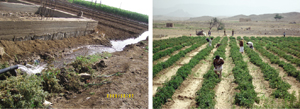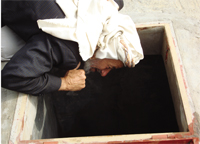
Yemen’s water crisis [Archives:2008/1210/Health]
November 24 2008
 |
 |
 |
and Yemen Times Staff
Traditional springs and wells used by Yemenis in rural areas have been gradually drying out because of the rapid depletion of groundwater. Rural communities have put their efforts together to dig deeper through the use of modern techniques, but this has led to the further exhaustion of groundwater resources to the extent that many Yemeni governorates are today at risk of drought.
Rainwater accumulated in the Sana'a basin over a whole year represents only half the amount of water consumed annually by the Sana'a governorate, mostly in irrigation.
The problem is the same all around the country because the rate of groundwater accumulation is always slower than the rate at which it is extracted for consumption, especially with the use of modern techniques.
There are areas in which the decline of the groundwater level is more than six meters a year. Even in coastal cities, the threat of water depletion has loomed. In Aden, some officials said that there has been a sudden drop in the levels of water reserves in the Gash field, the water basin that feeds the city. Whereas a well in this field used to produce 20 liters per second 18 years ago, it now only produces four liters per second, a 75 percent decrease from previous years.
Many main cities currently are experiencing unprecedented water shortage, particularly as Water Authorities are unable to keep pace with new housing and industrial developments. Such cities' water supply in basins is reducing dramatically.
For example, some families in Taiz city are allowed a water share only once every 10 days' however, this period has been extended to a month in order for water to reach houses. Therefore, city authorities negotiated 10 years with the nearby rural area of Habir before reaching an agreement in 2002. Taiz is allowed to extract water from a previously untapped deep aquifer in exchange for investments in the village's water supply, schools and women's centers, as well as joint monitoring of water extraction to ensure a sustainable flow.
Such struggle or competition is not strange in Yemen, wherein total annual renewable water resources are estimated at 2.4 billion cubic meters. Thus, with a population of around 21 million, this amounts to little more than 125 cubic meters per person annually, compared with the Middle East and North Africa average of 1.250 cubic meters per person.
According to World Bank reports, Yemen's problem is more critical given that water resources are distributed unevenly and that 90 percent of the population has less than 90 cubic meters of water annually for domestic use, which is 10 percent below the worldwide norm. Reports estimate that only 44 percent of the population has access to main water supplies and only 12 percent to safe sanitation.
In general, all surface water resources – 60 percent of Yemen's renewable resources – already are being exploited beyond the level of renewal. This very rapid development has brought with it major problems. Groundwater is being mined at such a rate that parts of the rural economy could dry up. Areas under greatest pressure are the central highlands, the western escarpment and coastal plains.
Although Yemen has many authorities specialized in dealing with water issues, such as the Ministry of Water and Environment (MWE) and the National Water Resource Authority (NWRA), these authorities face many difficulties in activating rules and policies. Such authorities have lacked the technical means, legal instruments and political will to regulate sinking of wells and groundwater extraction.
Yemen is one of the most water-scarce countries in the world with, according to government figures, water consumption per capita standing at 125 cubic meters per year, well below the global average of 1,500 cubic meters per year.
The water crisis has led to competition for limited water resources, an increase in the value of water and a decline in personal hygiene and ensuing diseases in some rural areas. The scarcity of water for irrigation in agriculture has led to internal displacement and disputes over water resources account for over 70 percent of tribal conflicts.
\”The total amount of water consumed annually in Yemen is 3.5 billion cubic meters


